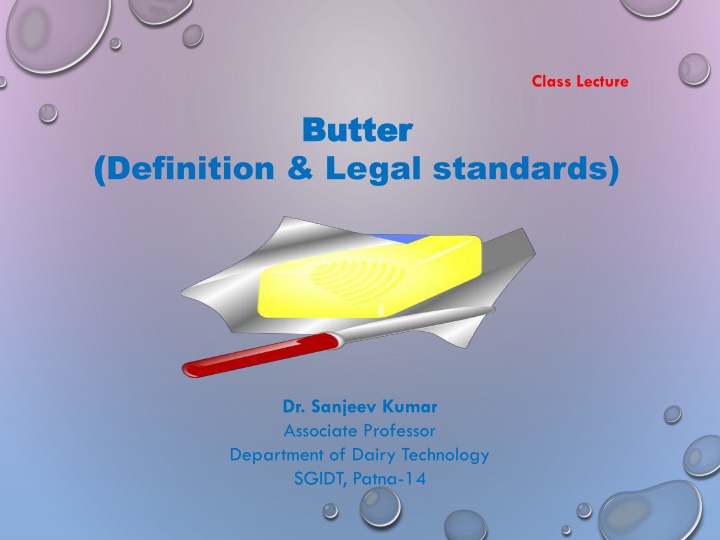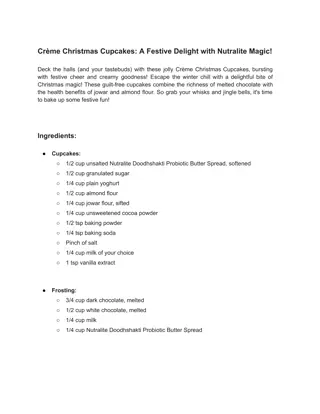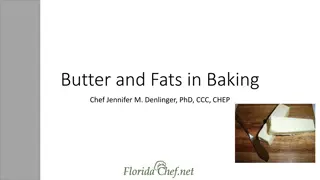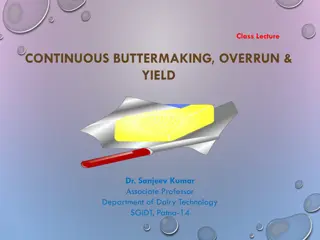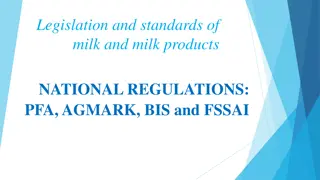Butter: Definition, Standards, and Composition
Explore the definition of butter according to FSSAI standards, including its composition, permitted additives, and classifications based on acidity, salt content, end-use, and manufacturing practices. Discover the nutritional composition and fatty acid profile of butter along with essential information on legal standards and regulations related to butter production and sale.
Download Presentation

Please find below an Image/Link to download the presentation.
The content on the website is provided AS IS for your information and personal use only. It may not be sold, licensed, or shared on other websites without obtaining consent from the author.If you encounter any issues during the download, it is possible that the publisher has removed the file from their server.
You are allowed to download the files provided on this website for personal or commercial use, subject to the condition that they are used lawfully. All files are the property of their respective owners.
The content on the website is provided AS IS for your information and personal use only. It may not be sold, licensed, or shared on other websites without obtaining consent from the author.
E N D
Presentation Transcript
Class Lecture Butter Butter ( (Definition & Legal standards) Dr. Sanjeev Kumar Associate Professor Department of Dairy Technology SGIDT, Patna-14
DEFINITION As per FSSAI (2011), Butter means the fatty product derived exclusively from milk of cow and/or buffalo or its products principally in the form of water-in-oil type of an emulsion. The product may be with or without added common salt and starter cultures of harmless lactic acid and/or flavour producing bacteria. Table butter shall be obtained from pasteurised milk and/or other milk products which have undergone adequate heat treatment to ensure microbial safety. It shall be free from animal body fat, vegetable oil and fat, mineral oil and added flavour. It shall have pleasant taste and flavour free from off flavour and rancidity. It may contain permitted food additives. It shall conform to the microbiological requirements of the regulation.
FSSAI Standards for Butter Note: Where butter is sold or offered for sale without any indication as to whether it is table or desi butter, the standards of table butter shall apply. BIS standards for pasteurized butter
Permitted food additives in butter as per FSSR Microbiological requirements of pasteurized butter (FSSAI, 2011) m, M denotes standard sampling procedure as given by FSSAI, 2011
Classification A. Classification based on acidity of cream used for butter making: 1. Sweet cream butter: pH of 6.4 2. Mildly acidified butter: pH in the range of 5.2 to 6.3 3. Sour cream butter : pH 5.1 B. Classification based on salt content 1. Salted butter 2. Unsalted butter C. Classification based on end use (as followed by BIS): 1. Table Butter 2. White Butter D. Classification based on the manufacturing practice (as followed by FSSAI): 1. Pasteurized cream butter/ Pasteurized Table butter 2. Desi butter
COMPOSITION OF BUTTER COMPOSITION OF BUTTER Sr Sr no no. . 1 2 3 4 Constituent Constituent Butter fat Moisture Salt Curd Percentage Percentage 80.0 83.0 15.5 16.0 0 - 3.0 1.0 -1.5
